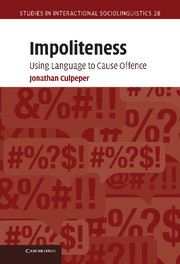Book contents
- Frontmatter
- Contents
- List of figures and tables
- Preface
- Introducing impoliteness
- 1 Understanding impoliteness I: Face and social norms
- 2 Understanding impoliteness II: Intentionality and emotions
- 3 Impoliteness metadiscourse
- 4 Conventionalised formulaic impoliteness and its intensification
- 5 Non-conventionalised impoliteness: Implicational impoliteness
- 6 Impoliteness events: Co-texts and contexts
- 7 Impoliteness events: Functions
- 8 Conclusions
- Notes
- References
- Index
2 - Understanding impoliteness II: Intentionality and emotions
Published online by Cambridge University Press: 16 May 2011
- Frontmatter
- Contents
- List of figures and tables
- Preface
- Introducing impoliteness
- 1 Understanding impoliteness I: Face and social norms
- 2 Understanding impoliteness II: Intentionality and emotions
- 3 Impoliteness metadiscourse
- 4 Conventionalised formulaic impoliteness and its intensification
- 5 Non-conventionalised impoliteness: Implicational impoliteness
- 6 Impoliteness events: Co-texts and contexts
- 7 Impoliteness events: Functions
- 8 Conclusions
- Notes
- References
- Index
Summary
Introduction
This chapter continues the investigation of key concepts constituting the notion of impoliteness. More specifically, it focuses on the concepts of intentionality and emotion, both of which have been utilised in definitions of impoliteness (see Section 1.1). Unlike the previous chapter, the two concepts in focus here are not closely related. I will first discuss intentionality and then emotions. In both, I will start by considering what the concept is, then move to the relationship with impoliteness, and finally deploy my diary report data. The final section of this chapter proposes a socio-cognitive model for understanding impoliteness in which the concepts discussed in this chapter and the previous are located.
Intentionality and offence
The notion of intentionality
Intentions and intentionality have become a battleground of much scholarly debate. As far as the field of pragmatics is concerned, this debate about intentions is usefully reviewed in Haugh (2008), a paper that acts as an introduction to a 2008 special issue (edited by Michael Haugh) of the journal Intercultural Pragmatics (8:2) on this topic. Traditional approaches to politeness, in particular B&L (1987) and Leech (1983), are underpinned by the Gricean notion that intentions exist a priori in the minds of speakers and that it is the recovery of a speaker's ‘polite’ intentions by hearers that leads to the understanding of politeness (see also Brown 1995).
- Type
- Chapter
- Information
- ImpolitenessUsing Language to Cause Offence, pp. 48 - 70Publisher: Cambridge University PressPrint publication year: 2011

